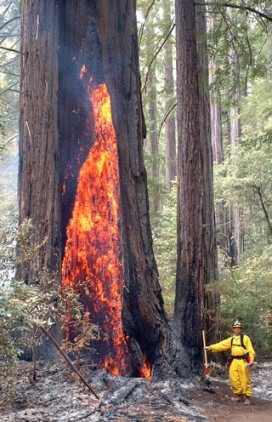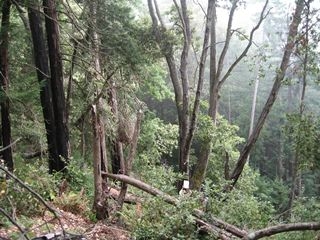
Millions of trees, including tanoaks, coast live oak, California bay laurels, and many other forest species have been killed by sudden oak death in coastal areas of central and northern California, and Oregon. The pathogen, Phytophthora ramorum, was first linked to the massive tree death in the mid-1990s.
David Rizzo, professor in the Department of Plant Pathology at UC Davis, and his research team are studying how the coastal forest ecology is changing since sudden oak death appeared, and why coast redwoods (Sequoia sempervirens) are subsequently so much more susceptible to fire.
It is the presence of the sudden oak death pathogen in forests that poses heavier fire risks for redwoods.
“If redwoods didn’t live in forests affected by the disease, they could withstand fires just fine,” says Margaret Metz, a postdoctoral research scholar working with Rizzo.

According to Rizzo, “The disease likely created more fuel for wildfires as dead tanoak branches fell. The loss of the oaks also would have decreased the amount of shade, drying out the forest and turning it into a tinder box, one not even redwoods could survive.”
A real key, though, is the finding that dead tanoaks, still standing, carry flames high into tree canopies, scorching the crowns of adjacent redwood trees. It’s this crown injury that is believed to have caused so many redwood trees to die in a number of fires that occurred in 2008.

Rizzo, noting that an increase in fire severity is resulting from climate change and global movement of species, says, “There may be all sorts of consequences, among them, dead and dying coast redwoods.”
Additional information:
- California's iconic redwoods in danger from fire and infectious disease. National Science Foundation report on Rizzo group’s work, August 2013
- The effects of sudden oak death and wildfire on forest composition and dynamics in the Big Sur ecoregion of coastal California. General technical report
- Ecology research article, Ecological Society of America
- California Oak Mortality Task Force website